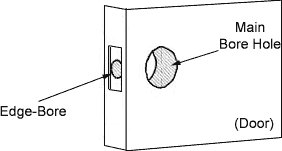
Imagine you’re gearing up to hang a new door in your home. You’ve got the door itself, new hinges, and a shiny doorknob. But wait—if the pre-bore isn’t the right size, all that shiny hardware won’t serve you much good. Understanding these sizes is key to ensuring a smooth installation and compatibility of the hardware you choose, whether it’s a classic knob or a sleek, modern lever.
What is Door Pre-Boring?
Pre-boring refers to the practice of drilling holes into a door to accommodate hardware, like knobs, locks, and hinges. Think of it as a door’s way of getting ready for the pieces that will make it functional. When a door is pre-bored, it has specific holes drilled in advance, which ensures that any hardware you choose will fit correctly.
Typically, there are two main types of pre-bore holes: one for the doorknob and another for the deadbolt. Each hole has its own diameter and depth, which is crucial for ensuring you can install your hardware without a hitch. If you’ve ever tried assembling furniture without the right pre-drilled holes, you know the frustration that can come with mismatched sizes.
Common Pre-Bore Sizes
Understanding the common pre-bore sizes can help you choose compatible hardware. Here are the most typical sizes you’ll encounter:
- Doorknob Hole: Usually 2-1/8 inches in diameter.
- Deadbolt Hole: Most commonly 1 inch in diameter.
- Hinge Plate Holes: These often have various sizes, usually around 3-1/2 inches to match standard hinge sizes.
Having the right sizes ensures that your hardware will fit snugly and securely, making your door both functional and attractive. If you’re not sure about these measurements, you can always measure them manually or check the specifications of your door or hardware.
The Importance of Accurate Measurements
Here’s the thing: taking accurate measurements is essential. If the pre-bore sizes don’t match your hardware, you’ll end up needing to modify the door or the hardware. This can lead to an uneven fit, which isn’t just unsightly; it can affect the door’s function. Imagine struggling with a doorknob that won’t turn or a lock that doesn’t catch. Not ideal, right?
For instance, if you’re using a pre-bored door but purchasing a different doorknob brand, you might find it’s too big or small. A little homework upfront can save you a lot of headaches later. Always double-check the pre-bore size against the hardware specifications before you start installation.
How to Measure Pre-Bore Sizes
Measuring pre-bore sizes isn’t rocket science, but it does require a bit of care. Here’s how you can do it:
1. Gather Tools: You’ll need a tape measure and possibly a caliper for more precise measurements.
2. Locate the Pre-bore Holes: Identify where the doorknob and deadbolt holes are located on your door.
3. Measure the Diameter: Use your tape measure or caliper to measure the width of each hole. Remember, you’re looking for the widest point.
4. Check the Depth: You can also measure how deep the holes go. This is important for your deadbolt, as it needs to fit snugly into the door.
Taking these steps will help ensure you get the right hardware that fits perfectly.
Choosing the Right Hardware
Once you know your pre-bore sizes, it’s time to pick your hardware. Imagine walking into a store full of doorknobs and deadbolts; it can be overwhelming! Look for hardware specifically labeled as compatible with your pre-bore size.
Many manufacturers provide compatibility information on packaging or their websites. For instance, if you have a 2-1/8 inch doorknob hole, you should look for knobs designed for that size. Some brands even specialize in unique designs that accommodate various pre-bore sizes. Shopping with knowledge in hand makes this process much easier.
Addressing Common Issues
Even with the right pre-bore sizes, issues can arise during installation. Here are a few common problems and how to tackle them:
– Mismatched Sizes: If your hardware doesn’t fit, don’t panic. You can purchase adapter kits or replacement hardware designed to fit standard sizes.
– Too Tight or Loose Fit: A tight fit can be frustrating, while a loose one can lead to wobbly hardware. If things seem off, check the alignment and readjust as necessary.
– Drilling New Holes: If you absolutely must drill new holes, make sure you measure twice and drill once to avoid any mistakes that could diminish your door’s integrity.
Understanding door pre-bore sizes is crucial for any successful installation of door hardware. Take your time to measure accurately, select compatible hardware, and address potential issues proactively. With a little preparation, you can transform your door into a well-functioning part of your home, complementing both your style and security needs.
So, the next time you’re faced with a door project, remember the importance of those little pre-bore holes. They may seem small, but they play a big role in ensuring your door hardware fits just right!